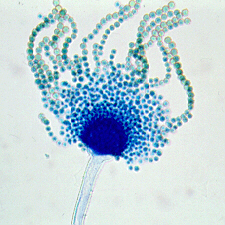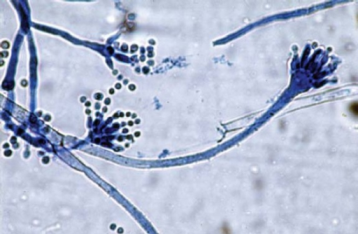Reproduction
 As
I mentioned in the classification section, Aspergillus is part
of the phylum Ascomycota. Members of this phylum produce
asexual spores externally as conidia. Something unusual about A.
flavus however, is that it is not known to produce sexually!
You may be wondering if that is the case then why are they not
grouped with the deuteromycetes, which is not a phylum of fungi
but a group known as the fungi imperfecti. Fungi considered to
be deuteromycetes have no know sexual state and often reproduce
asexually via conidia. Sounds a lot like Aspergillus flavus,
right? Well, molecular evidence tells us that the phylum
Ascomycota is in fact where this organism belongs.
However, some individuals consider it to have a double
classification in both of the groupings.
As
I mentioned in the classification section, Aspergillus is part
of the phylum Ascomycota. Members of this phylum produce
asexual spores externally as conidia. Something unusual about A.
flavus however, is that it is not known to produce sexually!
You may be wondering if that is the case then why are they not
grouped with the deuteromycetes, which is not a phylum of fungi
but a group known as the fungi imperfecti. Fungi considered to
be deuteromycetes have no know sexual state and often reproduce
asexually via conidia. Sounds a lot like Aspergillus flavus,
right? Well, molecular evidence tells us that the phylum
Ascomycota is in fact where this organism belongs.
However, some individuals consider it to have a double
classification in both of the groupings.
Advantages and Disadvantages
Asexual reproduction has an advantage. It is cheaper in
terms of energy to
reproduce this way for the organism compared to sexual
reproduction. The fact that these organisms can maintain
their survival and competitive edge without the benefits of
genetic recombination via sexual reproduction is impressive.
Some mycologists (biologists who study
fungi) believe that they do have a sexual stage that
just hasn't been discovered yet, while others believe that they
do not and receive genetic diversity through mutations alone. 
The disadvantages of reproducing by asexual means alone is that
sexual reproduction is a way to receive genetic recombination
and also offers more protection to offspring as opposed
to conidia. Sexual spores can also remain dormant until
conditions are more favorable for the organism.
The Process
Species of Aspergillus have hyphae that are branched and septate with multinucleate cells. A conidiophore is formed as a vertical branch of a horizontal cell known as a ‘foot-cell’, and the conidiophore ends in a multinucleate vessel. Phialides are produced in one rank directly from the vesicle, covering its entire surface, or in a secondary rank as branches of metulae which arise from the vesicle. The conidia are formed in basipetal chains from the phialides; they are dusty, dry and spherical. These conidia are dispersed by air currents. Among the genus Aspergillus, conidia vary in color, however, that of A. flavus is yellow. Conidium is actually the latin word for dust which is an appropriate label because most dust contains conidia! (Keep in mind that conidia=plural, conidium=singular.)
This fungi has interactions with other organisms including humans! To find out how you might be involved with A. flavus go to the interactions page.



